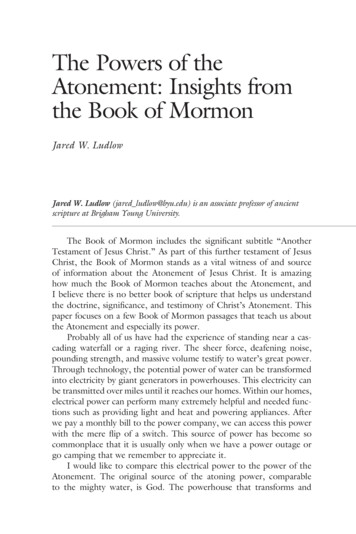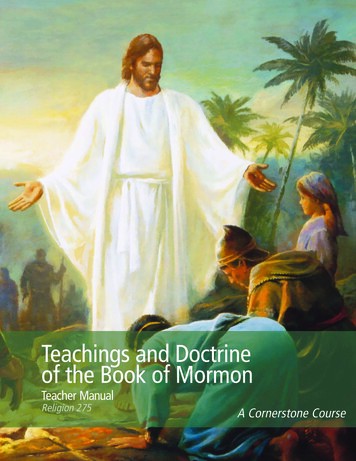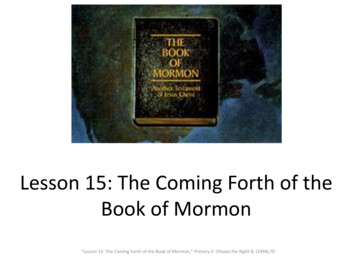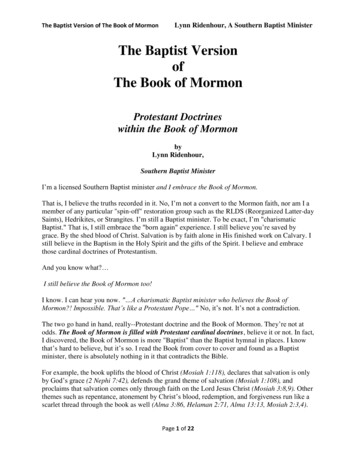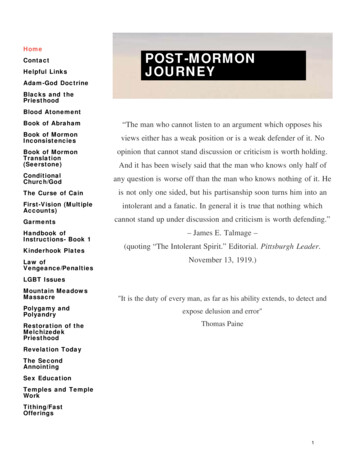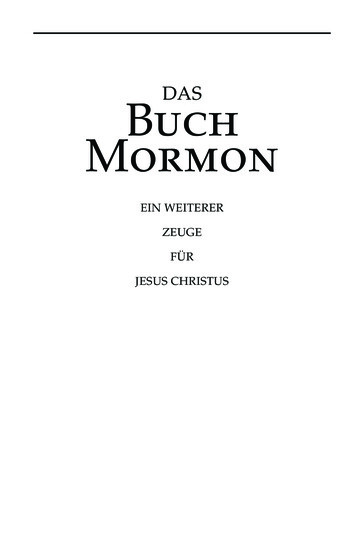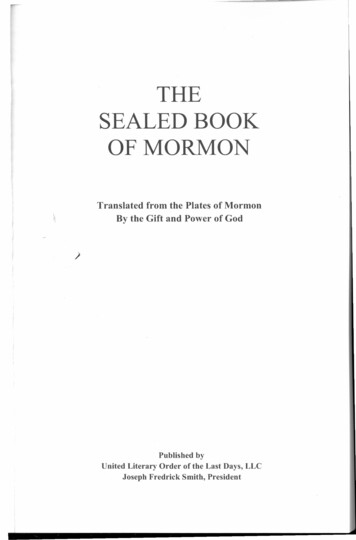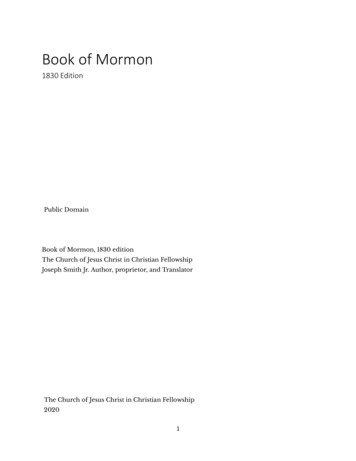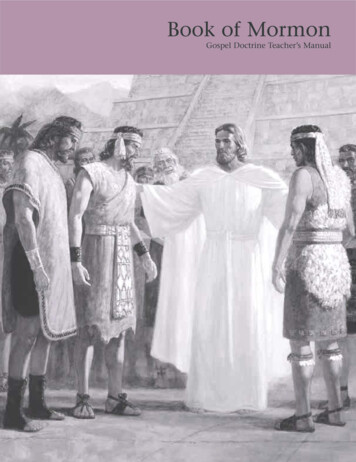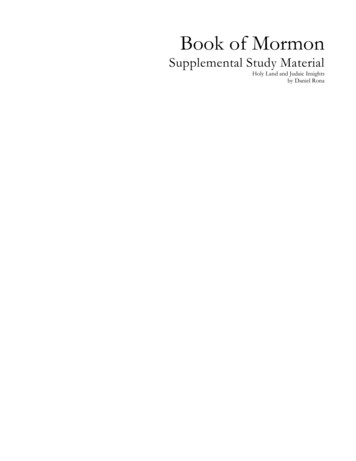
Transcription
Book of MormonSupplemental Study MaterialHoly Land and Judaic Insightsby Daniel Rona
ii
Book of MormonSupplemental Study MaterialHoly Land and Judaic InsightsBy Daniel RonaPublished byThe Ensign FoundationSalt Lake City, Utahiii
The Ensign FoundationMISSION:The Ensign Foundation is assisting in preparing people who considerthemselves of The House of Israel to be an Ensign to the nations.PURPOSES:The Ensign Foundation is facilitating the open exchange of dialogue inscientific, cultural, educational and economic projects between the peoplesof Joseph and Judah with confidence, openness and understanding, leadingup to a natural cooperation in uniting the Tribes of Joseph and Judah sothat they can ultimately be rebuilding Jerusalem and preparing to open themillennial period. The Foundation is giving people the opportunities toserve each other by giving service and funding bringing Jews and nonJews together in projects revealing the values and qualities of each other.PROJECTS INCLUDE:Scholarships and educational opportunities, Academic symposiums,Humanitarian Service, Concerts, Firesides, Lectures, Study materials inprint, audio and video formats.The ENSIGN FOUNDATION is a Charitable Non-profit 501c(3) Foundation #87-0518627The ENSIGN FOUNDATION6589 South 1300 East - Suite 150Salt Lake City, Utah 84121Telephone 801-699-9657Ensign@IsraelRona.comiv
Daniel Rona was born in Israel -- educated in America -- and has been a member of theChurch of Jesus Christ of Latter-day Saints since 1950. He was a well-known radiobroadcaster in Salt Lake City, St. Louis, Chicago and New York, as well as an internationalnewscaster for the “Voice of Israel.”In 1974, he returned to Israel with his wife, Marilyn, and their three children. Their familyhas grown to five children. Like all Israelis, his sons and daughters served in the IsraeliMilitary before their full-time missions.Brother Rona directs the nonprofit ENSIGN FOUNDATION which unites the people ofJudah and Joseph in educational, cultural and scientific activities. The Ensign Foundationalso provides learning experiences in the Holy Land. For twenty-seven years, Brother Ronahas been the only LDS licensed tour guide in Israel. His background is unique: he is anAmerican, an Israeli, a Mormon, and a Jew!Latter-day Saints, who have experienced ISRAEL REVEALED with Brother Rona, tell ofgreater enrichment in their lives through his spiritual and cultural insights. He harmonizesthe language, the culture, the time and the places of the Holy Land, sharing the deep feelingsand spirit of ancient and modern Israel. These are reflected in this Gospel Doctrinesupplement material which he has also provided weekly on the Internet. His book, ISRAELREVEALED, is an authoritative work bringing the ethnic cultures and traditions of theHoly Land into a spiritual and pictographic review. He also produced a TV mini-seriesabout Israel. These six TV-films are also on home-video cassettes.Brother Rona has served many years in the presidencies of the Israel District and JerusalemBranches.v
vi
ContentsLesson Number and TitleHelps for the Teacher and Student1 “The Keystone of Our Religion”2 “All Things According to His Will” (1 Nephi 1–7)3 The Vision of the Tree of Life (1 Nephi 8–11; 12:16–18; 15)4 “The Things Which I Saw While I Was Carried Away in the Spirit”(1 Nephi 12–14)5 “Hearken to the Truth, and Give Heed unto It” (1 Nephi 16–22)6 “Free to Choose Liberty and Eternal Life” (2 Nephi 1–2)7 “I Know in Whom I Have Trusted” (2 Nephi 3–5)8 “O How Great the Goodness of Our God” (2 Nephi 6–10)9 “My Soul Delighteth in the Words of Isaiah” (2 Nephi 11-25)10 “He Inviteth All to Come unto Him” (2 Nephi 26–30)11 “Press Forward with a Steadfastness in Christ” (2 Nephi 31–33)12 “Seek Ye for the Kingdom of God” (Jacob 1–4)13 The Allegory of the Olive Trees (Jacob 5–7)14 “For a Wise Purpose” (Enos, Jarom, Omni, Words of Mormon)15 “Eternally Indebted to Your Heavenly Father” (Mosiah 1–3)16 “Ye Shall Be Called the Children of Christ” (Mosiah 4–6)17 “A Seer . . . Becometh a Great Benefit to His Fellow Beings”(Mosiah 7–11)18 “God Himself . . . Shall Redeem His People” (Mosiah 12–17)19 “None Could Deliver Them but the Lord” (Mosiah 18–24)20 “My Soul is Pained No More” (Mosiah 25–28; Alma 36)2l “Alma . . . Did Judge Righteous Judgements” (Mosiah 29; Alma 1–4)22 “Have Ye Received His Image in Your Countenances?” (Alma 5–7)23 “More Than One Witness” (Alma 8–12)24 “Give us Strength According to Our Faith . . . in Christ”25 “They Taught with Power and Authority of God” (Alma 17–22)26 “Converted unto the Lord” (Alma 23–29)27 “All Things Denote There Is a God” (Alma 80849195100105107111vii
he Word Is in Christ unto Salvation” ( Alma 32-35)“Give Ear to My Words” (Alma 36-39)“The Great Plan of Happiness” (Alma 40-42)“Firm in the Faith of Christ” (Alma 43-52)“They Did Obey . . . Every Word of Command with Exactness”(Alma 53-63)“A Sure Foundation” (Helaman 1-5)“How Could You Have Forgotten Your God?” (Helaman 6-12)“Repent and Return unto the Lord” (Helaman 13-16)“On the Morrow Come I into the World” (3 Nephi 1-7)“Whosoever Will Come, Him Will I Receive” (3 Nephi 8-11)“Old Things Are Done Away, and All Things Have Become New”(3 Nephi 12-15)“Behold, My Joy is Full” (3 Nephi 17-19)“Then Will I Gather Them In” (3 Nephi 16, 20-21)“He Did Expound All Things unto Them” (3 Nephi 22-26)“This Is My Gospel” (3 Nephi 27-30; 4 Nephi)“How Could Ye Have Departed from the Ways of the Lord?”(Mormon 1-6; Moroni 9)“I Speak unto You As If Ye Were Present” (Mormon 7-9)“Never Has Man Believed in Me As Thou Hast” (Ether 1-6)“By Faith All Things Are Fulfilled” (Ether 7-15)“To Keep Them in the Right Way” (Moroni 1-6)“Come unto Christ” (Moroni 7-8; 0163169173178183
Supplemental InformationFor Old Testament StudiesThis material was prepared by Daniel Rona who, for twenty-seven years, has been the only LDSlicensed tour guide in Israel. For almost thirty years, he has been teaching the Old and NewTestaments in tours, as many as thirty times a year. Additionally, for years, he has directed numeroustours to the Book of Mormon Lands of Central America. Following the Footprints of the Savior, hebrings people to the bridge connecting the Ancient Holy Land to the Modern Promised Lands. Hewas born and lives in Israel. As an active LDS member and Church leader, Brother Rona combineshis gospel knowledge, Israel ethnicity and Jewish insights to assist in bringing the tribes of “Joseph”and “Judah” closer together. His background is unique in that he is an American, an Israeli, aMormon and a Jew.Under each scripture listing is a summary to the chapters being discussed. These are from the LDSScriptures and are provided only as an overview. It is important that the actual scriptures be read.The Holy Land and Jewish insights are added to help the teacher and student “go back” to thesetting in which the scriptures were given and also to better understand what general Judaic views areof those scriptures. Jewish views have varied with time and dispersion, yet understanding the Jews(basically Judah) will help Joseph in the prophetic mission of reuniting “Joseph and Judah.” That willbring us both back to the original understanding and truths that God gave to his children, yesterdayand today as well as tomorrow.Helps for the Teacher and StudentThe young prophet Nephi gave us a substantial key to understanding the scriptures. Notehow subtly he teaches us through a ‘chiasmas’ (an order of words listed in one direction to acenter thought and then listed in the other direction in reverse order).1.learning of my father2.highly favored of the Lord2.knowledge of the goodness and themysteries of God1.learning of the JewsI, Nephi, having been born of goodlyparents, therefore I was taught somewhat in all thelearning of my father; and having seen manyafflictions in the course of my days, nevertheless,having been highly favored of the Lord in all mydays; yea, having had a great knowledge of thegoodness and the mysteries of God, therefore Imake a record of my proceedings in my days.Yea, I make a record in the language ofmy father, which consists of the learning of theJews and the language of the Egyptians. (1 Nephi1:1-2)The center point of his instruction is the gift he acknowledges, the knowledge of mysteries.A synonym for mysteries is the “subtle understanding” of God’s word. This is availablethrough the Gift of the Holy Ghost.“For he that diligently seeketh shall find; and the mysteries of God shall beunfolded unto them, by the power of the Holy Ghost, as well in these times as inix
times of old, and as well in times of old as in times to come; wherefore, the course ofthe Lord is one eternal round.” (1 Nephi 10:19)“Angels speak by the power of the Holy Ghost; wherefore, they speak thewords of Christ. Wherefore, I said unto you, feast upon the words of Christ; forbehold, the words of Christ will tell you all things what ye should do.” (2 Nephi 32:3)The center point is sandwiched by “learning of my father” and “learning of the Jews.” Thismaterial suggests some ‘learning of the Jews’ to add insight to the study of the same religionand scriptures that Nephi brought from Israel. Other Jewish insights may simply helpLatter-day Saints better understand Judah and thereby bring our two families closer together.It is necessary for the teacher and the student to relate and coordinate this information withthe material provided in their respective lesson manuals.The basis of Jewish learning is based on the “Torah,” that is the first five books of the “OldTestament.”“The Bible is holy to Jews because it represents the Word of God. This is particularlytrue of the Torah which is, so to speak, God's direct statement. The halakhah, orJewish law, which is the authoritative guide for a Jew's life, is mainly based on theTorah, so obviously study of the Torah as well as the rest of the Bible is one of theprime religious duties.”“The custom of reading the Torah publicly is very, very ancient --- originating withEzra in the fifth-fourth centuries B.C.E. At some later date a reading from theNevi'im was added; this corresponding passage from the Prophets is known as theHaftorah.” (Encyclopedia Judaica Jr.)The Latter-day Saint’s use of the Book of Mormon is another part of LDS Haftorah.Literally, it is the reading of Nevi'im, the “Prophets,” in another land – with theirexplanations and heavenly insights – based on their constant advice to “go back” to thelearning of their Fathers. The first verse of the Book of Mormon reveals this key ofunderstanding God’s will, “learning of the fathers.” The Hebrew word for “going back” isthe same as “repent.” The Book of Mormon teaches Faith in the Lord as taught by truelearning of the fathers. That leads us to Repent, make the true covenant of Baptism andrewards us with the blessing of the Gift of the Holy Ghost.x
“The Keystoneof Our Religion”Lesson1Scripture Title page of the Book of Mormon: Taken from the plates of Nephi; Wherefore, it is an abridgment of the record of the people ofSummary: Nephi, and also of the Lamanites—Written to the Lamanites, who are a remnant of the house of Israel; and also to Jew andGentile—Written by way of commandment, and also by the spirit of prophecy and of revelation—Written and sealed up, and hid upunto the Lord, that they might not be destroyed—To come forth by the gift and power of God unto the interpretation thereof—Sealedby the hand of Moroni, and hid up unto the Lord, to come forth in due time by way of the Gentile—The interpretation thereof by the gift of God.An abridgment taken from the Book of Ether also, which is a record of the people of Jared, who were scattered at the time the Lord confounded thelanguage of the people, when they were building a tower to get to heaven—Which is to show unto the remnant of the House of Israel what great things theLord hath done for their fathers; and that they may know the covenants of the Lord, that they are not cast off forever— And also to the convincing of theJew and Gentile that JESUS is the CHRIST, the ETERNAL GOD, manifesting himself unto all nations—And now, if there are faults they arethe mistakes of men; wherefore, condemn not the things of God, that ye may be found spotless at the judgment-seat of Christ.SupplementalHoly Land The statement, “The Book of Mormon is the keystone of our religion” can be betterand Judaic understood by seeing remains of Roman architecture so prevalent in Israel. Each stone ofInsights:an archway is angled to wedge the others in place. The center stone is like the center point.The center point in a chiasmas is the focusing on the Lord. The Book of Mormon’s purposeis to focus on the Lord, the God of Israel. Consider the five “Standard Works (scriptures)”that Latter-day Saints use, the Old Testament, the New Testament, the Book of Mormon,the Doctrine and Covenants and the Pearl of Great Price. They are like an arch made of fivestones. Every stone in the arch is necessary to have the advantage of the structure whichholds a building in place as well as having the enjoyment of the beauty in something thatholds itself together. This is a visual metaphor of truth.Additionally, the Book of Mormon gives us a history of Jews leaving the land of Israel andgoing to what is called the land of America. This history is valuable because it is anunprejudiced account. Daniel Ludlow taught that even true history is usually prejudiced bythe writer and his perceptions as he saw events happening. Conversely, true prophesy doesnot have prejudice, because it has not happened yet. He also taught that scriptural historyhas the least amount of prejudice because in most cases it carries a message of future events.It is prophesy in the form of history. Therefore, the history is accurate.The ancient prophets could not (and would not) write all that happened. They selected towrite those things which would apply as lessons of the future.“And a hundredth part of the proceedings of this people, which now began tobe numerous, cannot be written upon these plates; but many of their proceedings arewritten upon the larger plates, and their wars, and their contentions, and the reignsof their kings.” (Jacob 3:13)“Wherefore, I chose these things, to finish my record upon them, whichremainder of my record I shall take from the plates of Nephi; and I cannot write thehundredth part of the things of my people.” (Words of Mormon 1:5)1
“But behold, a hundredth part of the proceedings of this people, yea, theaccount of the Lamanites and of the Nephites, and their wars, and contentions, anddissensions, and their preaching, and their prophecies, and their shipping and theirbuilding of ships, and their building of temples, and of synagogues and theirsanctuaries, and their righteousness, and their wickedness, and their murders, andtheir robbings, and their plundering, and all manner of abominations andwhoredoms, cannot be contained in this work.” (Helaman 3:14)“And there had many things transpired which, in the eyes of some, would begreat and marvelous; nevertheless, they cannot all be written in this book; yea, thisbook cannot contain even a hundredth part of what was done among so manypeople in the space of twenty and five years . . .” (3 Nephi 5:8)2
“All Things Accordingto His Will”Lesson21 Nephi 1–7Scripture An account of Lehi and his wife Sariah and his four sons, being called, (beginning at the eldest) Laman, Lemuel, Sam, and Nephi.Summary: The Lord warns Lehi to depart out of the land of Jerusalem, because he prophesieth unto the people concerning their iniquity and theyseek to destroy his life. He taketh three days’ journey into the wilderness with his family. Nephi taketh his brethren and returneth tothe land of Jerusalem after the record of the Jews. The account of their sufferings. They take the daughters of Ishmael to wife. Theytake their families and depart into the wilderness. Their sufferings and afflictions in the wilderness. The course of their travels. They come to the largewaters. Nephi’s brethren rebel against him. He confoundeth them, and buildeth a ship. They call the name of the place Bountiful. They cross the largewaters into the promised land, and so forth. This is according to the account of Nephi; or in other words, I, Nephi, wrote this record.Lehi takes his family into the wilderness by the Red Sea—They leave their property—Lehi offers a sacrifice to the Lord and teaches his sons to keep thecommandments—Laman and Lemuel murmur against their father—Nephi is obedient and prays in faith; the Lord speaks to him, and he is chosen torule over his brethren.Lehi’s sons return to Jerusalem to obtain the plates of brass—Laban refuses to give them up—Nephi exhorts and encourages his brethren—Labansteals their property and attempts to slay them—Laman and Lemuel smite Nephi and are reproved by an angel.Nephi slays Laban at the Lord’s command and then secures the plates of brass by stratagem—Zoram chooses to join Lehi’s family in the wilderness.Sariah complains against Lehi—Both rejoice over the return of their sons—They offer sacrifices—The plates of brass contain writings of Moses and theprophets—They identify Lehi as a descendant of Joseph—Lehi prophesies concerning his seed and the preservation of the plates. [Between 600 and 592B.C.]Nephi writes of the things of God—His purpose is to persuade men to come unto the God of Abraham and be saved. [Between 600 and 592 B.C.]SupplementalHoly Land The very first verse of the Book of Mormon reveals several keys to understanding God’sand Judaic will. There is a lesson in honoring “goodly parents.” It is one of the basic commandments.Insights:“Honour thy father and thy mother: that thy days may be long upon the landwhich the LORD thy God giveth thee.” (Exodus 20:12)“It is also customary to visit the graves of deceased parents . . . The reasons for thiscustom vary from the belief that the righteous dead may help the living, to the ideathat respect for parents and the inspiration gained from the example of their lives,are values to be emphasized especially at this time.” (Encyclopedia Judaica Jr.)There is a lesson in going back to the “learning of the fathers.” The Hebrew word for“going back” is the same as “repent.”“Say nothing but repentance unto this generation; keep my commandmentsand assist to bring forth my work, according to my commandments, and you shall beblessed.” (Doctrine & Covenants 6:9)There is a lesson in combining an understanding of the “Learning of the Jews” and knowingthe “mysteries” of the Lord.“For he that diligently seeketh shall find; and the mysteries of God shall beunfolded unto them, by the power of the Holy Ghost, as well in these times as intimes of old, and as well in times of old as in times to come; wherefore, the course ofthe Lord is one eternal round.” (Nephi 10:19)3
Lesson 2In using the learning of his fathers, Nephi uses one of the typical ways of Jewish learning, toconsider the “opposite” point of view.Laman & Lemuel, Sons of LehiNephi, Son of Lehi1.Goodly Parents1 Nephi 1:11.Murmured1 Nephi 2:11-12, 1 Nephi 3:5, 1 Nephi 4:142.Believed His Father1 Nephi 2:162.Didn’t Believe1 Nephi 2:133.Went to The Lord for Understanding1 Nephi 2:16, 193.Knew Not The Dealings of God1 Nephi 2:124.Willing to Do What Lord Commanded1 Nephi 3:74.Complained1 Nephi 2:16, 1 Nephi 3:5, 1 Nephi 3:28, 1Nephi 3:31, 1 Nephi 4:45.Refused to Return Without Records1 Nephi 3:155.Wanted to Give Up1 Nephi 3:146.Knew The Lord Was Mightier1 Nephi 4:146.Doubted The Lord1 Nephi 3:31Nephi’s experience with Laban and the subsequent slaying of Laban can be compared totwo other occurrences. In Jesus’ day, Caiaphas the high priest called for taking Jesus’ lifeand then perpetrated a scheme to have Jesus crucified. In 1995, Yigal Amir planned ascheme and then was convicted of assassinating Yizhak Rabin, the Prime Minister of Israel.In each case the justification of taking a life was based on the premise that it would “save thepeople.”4
Lesson 2Nephi“And it came to pass thatthe Spirit said unto me again:Slay him, for the Lord hathdelivered him into thy hands;Behold the Lord slayeth thewicked to bring forth hisrighteous purposes. It is betterthat one man should perish thanthat a nation should dwindle andperish in unbelief.And now, when I, Nephi,had heard these words, Iremembered the words of theLord which he spake unto me inthe wilderness, saying that:Inasmuch as thy seed shall keepmy commandments, they shallprosper in the land of promise.”(1 Nephi 4:12-14)Nephi’s belated decision totake Laban’s life came fromtrue revelation and sanctionfrom God.Caiaphas“Then gathered the chiefpriests and the Pharisees acouncil, and said, What do we?for this man doeth manymiracles.If we let him thus alone, allmen will believe on him: andthe Romans shall come andtake away both our place andnation.And one of them, namedCaiaphas, being the high priestthat same year, said unto them,Ye know nothing at all,Nor consider that it isexpedient for us, that one manshould die for the people, andthat the whole nation perishnot.And this spake he not ofhimself: but being high priestthat year, he prophesied thatJesus should die for that nation;And not for that nationonly, but that also he shouldgather together in one thechildren of God that werescattered abroad.”(John11:47-52)Caiaphas eagerly wantedJesus dead because he and afew priests wanted to protectand keep power and position.Yigal Amir“YIGAL Amir completedhis testimony in Tel AvivDistrict Court yesterday,declaring that he had indeedintended to kill Rabin,justifying his actions, andarguing with the judge.”(Jerusalem Post,Rainemarcus, March 8,1996)“YIGAL Amir, testifyingfrom the witness stand forthe first time yesterday, toldTel Aviv District Court thatHalacha dictated heassassinate Yitzhak Rabin.”(Jerusalem Post, NewsAgencies, March 5, 1996)“Mo nt h s b e fo r e theassassination of primeminister Yitzhak Rabinhundreds of people turnedto Beit El rabbi ShlomoAviner for an opinion on thedin rodef concept asregards Rabin, the rabbisaid in court yesterday.”(Jerusalem Post, GalitLipkis Beck, March 18,1998)Yigal Amir and otherswanted Rabin dead basedon their religious orpolitical perception ofprotecting the people.A display in the Israel Museum of Jerusalem shows artifacts from a cave some twenty-three miles southwest of Jerusalem in an area known as Lhi (Lahi or Lehi). They aredated to six hundred years before Jesus’ time and seem to connect to Lehi’s familydeparting the area of Jerusalem. The oldest-known writing of the name Jerusalem andthe spelling out of the name Jehovah appears in this cave.Three sentences on the cave walls suggest that the writers were: Hiding from enemiesseeking their lives, seeking forgiveness for wrong doings, and hoping for a salvationof Jerusalem. These could be considered similar to the descriptive Book of Mormonaccount of a “family of Jews” leaving Jerusalem in Judea at about six hundred yearsbefore Jesus’ time. Their father, Lehi, was one of the prophets of the day.5
“For it came to pass in the commencement of the first year of the reignof Zedekiah, king of Judah, (my father, Lehi, having dwelt at Jerusalem in allhis days); and in that same year there came many prophets, prophesying untothe people that they must repent, or the great city Jerusalem must bedestroyed.” (1 Nephi 1:4)Four brothers returned to retrieve their family and religious records. The recordkeeper sent his servants to kill them. Hiding in a cave, two brothers rebelled andthen were called to repentance by a heavenly messenger. The brothers may havesought forgiveness.“And it came to pass that we fled into the wilderness, and the servants ofLaban did not overtake us, and we hid ourselves in the cavity of a rock. Andit came to pass that Laman was angry with me . . . And it came to pass as theysmote us with a rod, behold, an angel of the Lord came and stood beforethem, and he spake unto them, saying: Why do ye smite your younger brotherwith a rod? Know ye not that the Lord hath chosen him to be a ruler overyou, and this because of your iniquities? Behold ye shall go up to Jerusalemagain, and the Lord will deliver Laban into your hands.” (1 Nephi 3:27-29)The youngest of these brothers later became a prophet and wrote of Jerusalem inlatter days:“And now this I speak because of the spirit which is in me. Andnotwithstanding they have been carried away they shall return again, andpossess the land of Jerusalem; wherefore, they shall be restored again to theland of their inheritance.” (2 NEPHI 25:11)Interestingly, that group was led by a man named Lehi and in archaeological recordsthe cave is called “Khirbet (ruins) Bet (house) LHI (Lehi).6
The Vision of theTree of LifeLesson31 Nephi 8–11; 12:16–18; 15Scripture Lehi sees a vision of the tree of life—He partakes of its fruit and desires his family to do likewise—He sees a rod of iron, a straitSummary: and narrow path, and the mists of darkness that enshroud men—Sariah, Nephi, and Sam partake of the fruit, but Laman andLemuel refuse.Nephi sees in vision: the land of promise; the righteousness, iniquity, and downfall of its inhabitants; the coming of the Lamb of God among them; howthe twelve disciples and the twelve apostles shall judge Israel; the loathsome and filthy state of those who dwindle in unbelief.Lehi’s seed are to receive the gospel from the Gentiles in the latter days—The gathering of Israel is likened unto an olive tree whose natural branches shallbe grafted in again—Nephi interprets the vision of the tree of life and speaks of the justice of God in dividing the wicked from the righteous. [Between600 and 592 B.C.]SupplementalHoly Land Dreams are one of the means God has of communicating with his children. Some of them,and Judaic the Prophets, have the responsibility of teaching us what those dreams mean.Insights:“Dreams have fascinated people through the ages. The Biblical view was that dreamsare divine communication --- events transpiring on a supernatural plane. Thus,dreams were regarded as omens, which could be interpreted only by visionaries orprophets, who were in touch with this ‘divine dimension.’ In the Bible, ‘dreamer,’‘prophet,’ and ‘magician’ are related terms.” (Encyclopedia Judaica Jr.)The Biblical accounts of Joseph and Daniel have a great basis in dreams, some irritatedfamily or friends and others brought redemption for people as well as condemnation ofpeople in the lands where they lived.“Joseph was one such interpreter; he explained Pharaoh's dreams of the fat and thincows as symbolizing seven years of plenty followed by seven years of hunger(Genesis 41). God's promise to Abraham about the inheritance of the land of Israelcame in a dream (Genesis 15) and Samuel's first prophecies were stimulated byGod's calling to him in a dream (Samuel 1:3).”“Because of his great wisdom and ability to interpret dreams, Daniel rose topositions of responsibility and honor in the court of kings Nebuchadnezzar,Belshazzar and Darius. However, as a Jew, he was constantly tormented by his rivalswho denounced him for not worshiping the idols of the land. Daniel's piety and faithin God always stood firm and despite all dangers, he continued to pray daily in thetraditional Jewish way. When, as punishment, his enemies cast him into a lion's den,he was prepared to sacrifice his life. The next morning when the king same to seeDaniel's fate, he found him calmly reciting.” (Encyclopedia Judaica Jr.)The imagery of the Tree of Life is strong in Jewish culture. On the precious silver plates thatI found in the store of a well known Jewish Scribe in the Old City of Jerusalem there is a“tree” with branches, laden with “fruit” with a stream of “water” flowing by. The words onthis small sculpture fashioned as a flat square plate come from the Talmud. They recite part7
Lesson 3of a parable that a tree watered by “living water,” has precious “fruit” that you would bringyour children to partake of.“Adam represents all of mankind; the Garden of Eden, the world; the Tree of Life,the Torah; and the serpent, the evil inclination. Just as Adam is placed in the Garden,in the midst of which stands the Tree of Life, so man is placed in the world in orderto observe the commandments of the Torah.” (Encyclopedia Judaica Jr.)Fruit has a strong imagery in the scriptures, as well.“A part of the first harvest each year of grains and of fruits was to be brought to theTemple in Jerusalem as a thanksgiving offering to God obeying the commandment:‘The choice first fruits of your soil shall you bring to the house of the Lord’ (Exodus34:33).” (Encyclopedia Judaica Jr.)White as a color is a combination of all colors. That may mean a “wholeness” or“completeness.” Garments used by religious Jews are often pure white.“In Ashkenazi tradition it is not just the bride who wears white on her wedding day.The groom, too, stands under the canopy wearing his white kitel, or robe, over hiswedding finery. The day of their marriage is a solemn one for the bride and groom.They pray that their past sins will be forgiven and they can start their life togetherafresh. The white of their clothing symbolizes the purity and the forgiveness of sinfor which they are hoping. For this reason a similar garment is used to clothe thedead for burial. The kitel therefore also serves to remind the wearer of how brief lifeis, and of the necessity for atonement.” (Enclyclopedia Judaica Jr.)The white bread used for the Sabbath apparently has to be sweet also.“Rabbinic tradition made hallah a special mitzvah for women. Today the word isgenerally used to mean the white Sabbath and festival loaf. And the mitzvah ofseparating hallah is followed by observant Jews in their bakeries and in homes wherethe art of baking fresh hallah is still practiced.”“Loaves of hallah appear in forms ass
and spirit of ancient and modern Israel. These are reflected in this Gospel Doctrine supplement material which he has also provided weekly on the Internet. His book, ISRAEL REVEALED, is an authoritative work bringing the ethnic cultures and traditions of the Holy Land into a spiritual and pictographic review. He also produced a TV mini-series
